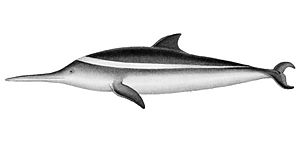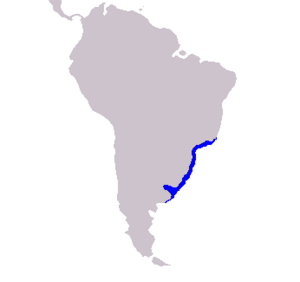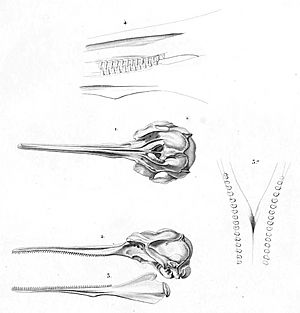La Plata dolphin facts for kids
Quick facts for kids La Plata dolphinTemporal range: Pliocene-recent
|
|
|---|---|
 |
|
| Illustration from 1847 | |
 |
|
| Size compared to an average human | |
| Conservation status | |
| Scientific classification | |
| Genus: |
Pontoporia
|
| Species: |
blainvillei
|
 |
|
| La Plata dolphin range | |
The La Plata dolphin, also known as the franciscana or toninha (scientific name: Pontoporia blainvillei), is a type of dolphin. You can find it in the coastal Atlantic waters of southeastern South America. This dolphin is special because it's the only one in its group that lives in the ocean and saltwater estuaries. Other dolphins in its group live only in freshwater rivers.
Sadly, human activities can harm the La Plata dolphin. Areas with lots of farms or factories often create pollution. This pollution can damage the dolphin's home and make their food unsafe to eat.
Contents
About the La Plata Dolphin's Name
The La Plata dolphin is the only species in its group, called Pontoporia. It's often placed in its own family, called Pontoporiidae.
Scientists Paul Gervais and Alcide d'Orbigny first described this dolphin in 1844. The second part of its scientific name, blainvillei, honors a French zoologist named Henri Marie Ducrotay de Blainville.
People in Argentina and Uruguay call it the Franciscana. This name is now used all over the world. In Brazil, it's known as the toninha. Another common name is cachimbo.
What Does the La Plata Dolphin Look Like?
The La Plata dolphin has the longest beak (or snout) compared to its body size of any living cetacean. Its beak can be up to 15% of its total body length in older adults.
Male dolphins grow to about 1.6 meters (5.2 feet) long. Females can be a bit larger, reaching up to 1.8 meters (5.9 feet). Their bodies are a brownish-grey color, with a lighter belly.
Their flippers are very large and wide compared to their body. They are almost triangular in shape. The edges of their flippers are a bit bumpy. The dolphin's blowhole is shaped like a crescent moon. It sits just in front of a crease in its neck. This makes it look like the dolphin is always looking up.
The dorsal fin on its back has a long base and a rounded tip. La Plata dolphins have many cone-shaped teeth. They can have between 48 and 61 teeth on each side of their upper and lower jaws.
These dolphins can weigh up to 50 kilograms (110 pounds). They can live for up to 20 years.
Reproduction and Life Cycle
La Plata dolphins usually become old enough to have babies between two and three years of age. However, in some groups, it might take as long as five years.
It's hard to watch La Plata dolphins in the wild. But scientists have studied a group near Brazil to learn about their breeding habits. Most of the young dolphins observed were born between September and February. This is during the spring and summer in the Southern Hemisphere.
A La Plata dolphin pregnancy lasts about 11 months. When born, calves are usually 70 to 75 centimeters (28 to 30 inches) long. They stop drinking their mother's milk when they are about one year old. Females might start having calves by the time they are five years old.
There is some evidence that these dolphins have a two-year cycle for having babies. More research is needed to be sure about this.
Behavior and What They Eat
The La Plata dolphin is often hard to spot. It moves very smoothly and slowly. You might only see it if the water is very calm.
These dolphins usually swim alone or in small groups. Sometimes, larger groups of up to 15 dolphins have been seen. La Plata dolphins are bottom feeders. This means they look for food on the seafloor.
Scientists have looked at what's inside their stomachs. They found that these dolphins eat at least 24 different species of fish. What they eat depends on which fish are most common in their area. They also eat octopus, squid, and shrimp.
Bigger animals hunt La Plata dolphins. These include killer whales (orcas) and several types of sharks.
Where Do La Plata Dolphins Live?
The La Plata dolphin lives in the coastal Atlantic waters of southeastern South America. This includes the Río de la Plata estuary. Their home range stretches from the Tropic of Capricorn near Ubatuba, Brazil, all the way south to Península Valdés, Argentina.
As mentioned, it's the only river dolphin that lives in the ocean and saltwater estuaries. While some dolphins of this species spend time in the ocean, many live their entire lives within rivers. They might never go out into the open ocean.
Dolphins have been seen in places like Miramar and Buenos Aires Province in Argentina. They are also found along the Brazilian coast. Here, they are usually seen in waters that are 8 to 30 meters (26 to 98 feet) deep. Sometimes, they are found in slightly deeper waters, up to 35 meters (115 feet). There are also a few reports of them being further away from the shore.
Threats to La Plata Dolphins
The La Plata dolphin faces dangers like damage to its home and water pollution. Scientists have found plastic and other man-made materials in the stomachs of these animals. More studies are needed to fully understand how these things affect the dolphins' health.
In Guanabara Bay, 90% of the La Plata dolphin population was lost in just 30 years. These dolphins also get caught in fishing nets and other fishing gear while they are looking for food. This is a major threat.
Areas with a lot of farms or factories often have runoff and waste. This pollution can harm the dolphins' living areas. It can also put toxic chemicals into the fish that dolphins eat.
Because La Plata dolphins are small and are hunted by sharks and killer whales, they tend to be quiet. They usually stay in shallow coastal waters.
Protecting La Plata Dolphins
The La Plata dolphin is listed as "Vulnerable" on the IUCN Red List of Threatened Species. This means it's at risk of becoming endangered.
The Franciscana is a special concern for conservation. This is because it lives in a limited area. It is also very likely to get accidentally caught in fishing gear. Many dolphins are killed in gillnets. In the 1970s, the biggest catches were in Uruguay. But in recent years, many have also been caught in southern Brazil and Argentina.
Scientists from all three countries are worried. They have asked for international help to highlight the dolphin's difficult situation.
The species is listed on Appendix I and Appendix II of the Convention on the Conservation of Migratory Species of Wild Animals (CMS).
- Appendix I means the species is in danger of extinction in all or a large part of its home range. Countries involved try to protect these animals strictly. They work to save or restore the places where they live. They also try to remove things that block their migration and control other dangers.
- Appendix II means the species needs better protection or would benefit from countries working together.
In 2011, a young La Plata dolphin was rescued off Montevideo, Uruguay. In February 2016, a young dolphin died on a beach in Santa Teresita, Argentina. Reports spread that the dolphin died after people passed it around for selfies. However, the photographer of the images later said this was not true. It's important to remember that wild animals should not be disturbed.
See also
 In Spanish: Franciscana para niños
In Spanish: Franciscana para niños
- List of cetaceans
- La Plata River environmental issues



